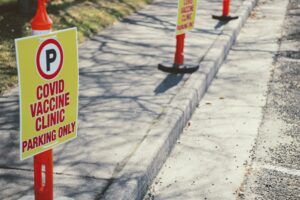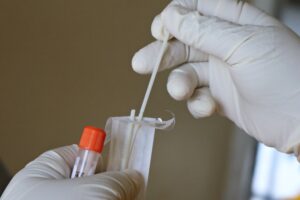Editor’s note: This op-ed was first published in The Orange County Register on July 22, 2022.
Last week, Los Angeles County Public Health Director Barbara Ferrer announced that the county had entered the CDC’s “High” tier of community COVID risk, and that a mask mandate is therefore in the works. There’s a problem, though: L.A. County isn’t actually in the “High” tier.
The CDC now classifies the COVID risk in each county with a metric called “Community Levels” that incorporates both case counts and hospitalization rates. The Community Levels system was implemented to ensure that public health recommendations or mandates are not triggered by widespread mild illness, replacing an earlier system that only looked at positive test counts. To enter the “High” risk Community Level, a county must have more than 10 new COVID hospitalizations per 100,000 people over a seven-day period. CDC data show L.A. County at 11 per 100,000, so by that measure L.A. County is designated “High.”
Beneath those numbers, though, is a critical error: most of those “COVID hospitalizations” aren’t actually caused by COVID. They represent people coming to the hospital for unrelated reasons who just happen to test positive at the time. We know this from Public Health’s own data, which reports that since March only 40% of COVID-positive hospitalizations in the county have actually been caused by COVID. If only true COVID hospitalizations are counted to accurately reflect the virus’s impact, the county easily drops out of the “High” tier.
Sign up for Schaeffer Center news
According to Los Angeles County Department of Health Services hospital officials, even the 40% number is a large overestimate. In a remarkable video from the day of Dr. Ferrer’s mandate announcement, Chief Medical Officer Dr. Brad Spellberg said of COVID admissions at Los Angeles County+USC Medical Center, “90% of the time it is not due to COVID. Only 10% of our COVID-positive admissions are due to COVID. Virtually none of them go to the ICU, and when they do go to the ICU it is not for pneumonia. They are not intubated … we haven’t seen one of those since February.” Health Services confirmed these facts in a statement: “We currently have 30 COVID-positive patients in the hospital, of whom three were admitted for COVID, none of whom are in the ICU.”
Hospital epidemiologist Dr. Paul Holtom summarized the situation this way: “As of this morning, we have no one in the hospital who had pulmonary disease due to COVID … Certainly, there’s no reason from a hospitalization-due-to-COVID perspective to be worried at this point.”
The problem is not limited to just L.A. County: San Diego Unified School District is re-instituting restrictions based on the same flawed Community Levels metric. In contrast, other counties that are also technically in the “High” tier understand the data and are not even considering mandates. Marin County, for example, separates COVID-positive hospitalizations by cause to avoid confusion.
The case for new mandates is further undermined by the growing scientific literature showing mask mandates to be ineffective. In the pandemic turmoil of 2020, most studies didn’t have the ability to compare COVID rates with and without masks in groups that were otherwise carefully matched. Claims of mask efficacy were thus based on studies with no or improper control groups. Other studies have relied on phone surveys or mathematical models rather than direct measurements of infection or transmission, or used contact tracing protocols that excluded counting masked transmission.
Now in mid-2022 we have much better data. Exhaustive tracking of in-school COVID spread was indistinguishable with and without student mask use in studies in Spain, a conclusion repeated in two separate COVID waves. Studies of student masking with control groups in Georgia, North Dakota, Finland and the UK have all found the same lack of any clear benefit. One randomized controlled trial showed no significant benefit to the mask wearer, and a second randomized trial found a slight benefit (and only in older adults) that was not reproduced with a different analysis of the same data.
When researchers repeated a CDC study showing a mask benefit using identical methods but a larger and better dataset, the benefit of masking disappeared.
Influenza transmits by the same aerosol route as COVID, so we must add the results of 10 randomized controlled trials on masking and influenza, which the CDC reviewed and “found no significant effect of face masks on transmission.”
All of this explains why White House COVID-19 Response Coordinator Ashish Jha found no difference in Omicron infection rates between mask-mandated California and mask-mandate-free Florida, or why Alameda County’s recent mask mandate produced no difference in COVID rates versus neighboring counties.
Using data that doctors and scientists agree are not accurate to justify an ineffective mandate is terrible policymaking. Public health mandates aren’t harmless, especially for children, students, parents, and families, who should not have to enter a fourth school year with restrictions based on fear not science.
Scott Balsitis, Ph.D trained in pandemic preparedness in the CDC’s Emerging Infectious Diseases program, and is currently a viral immunologist and vaccine developer in San Mateo County.
Jeffrey Klausner, MD, MPH is clinical professor of Medicine, Infectious Diseases, Population and Public Health, Keck School of Medicine of the University of Southern California. Dr. Klausner is a former CDC medical officer and former San Francisco city and county deputy health officer.
Houman Hemmati, MD, Ph.D is a Los Angeles-based board-certified physician, pediatric clinical researcher and biotech executive.
Neeraj Sood, Ph.D is a professor of health policy at Price School of Public Policy and director of the COVID Initiative at Schaeffer Center at the University of Southern California.
Related Work
-
Press Release
Traditional Vaccination Playbook Doesn’t Work with COVID
-
Perspective
The High Cost of ‘Free’ Covid Testing



